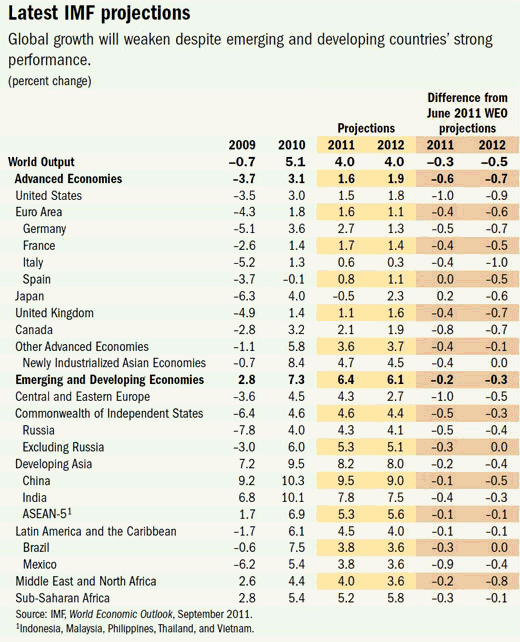
Typical street scene in Santa Ana, El Salvador. (Photo: iStock)
IMF Survey: Weak and Bumpy Global Recovery Ahead
September 20, 2011
- Global growth forecast to moderate to 4 percent in 2011 and 2012
- Advanced economies facing anemic growth of only 1.6 percent in 2011
- Multiple shocks combined with insufficient rebalancing stalling recovery
The global economic recovery is slowing, with world growth projected at 4 percent in both 2011 and 2012, down from over 5 percent in 2010, the IMF said in its latest forecast.

Auto assembly line in Maranello, Italy: global activity has weakened, become more uneven, IMF says in World Economic Outlook (photo: David Ebener/dpa)
WORLD ECONOMIC OUTLOOK
And even this lowered projection counts on a lot going well.
The IMF foresaw a slowdown this year after strong growth in 2010 as fiscal stimulus packages in response to the crisis wound down. But a barrage of economic shocks in 2011 combined with other factors for a worse than anticipated outcome.
“The global economy is in a dangerous new phase. Global activity has weakened and become more uneven, confidence has fallen sharply recently, and downside risks are growing,” the IMF said in its September 2011 World Economic Outlook (WEO).
The report, released in Washington on September 20, says strong and coordinated action is necessary to avert a decade of lost growth in the advanced economies.
“Strong policies are urgently needed to improve the outlook and to reduce the risks,” said IMF Chief Economist Olivier Blanchard. “Only if governments move decisively on fiscal policy, financial repairs, and external rebalancing, can we hope for stronger and more robust recovery.”
Uneven growth
Real GDP is expected to grow by a fairly robust 6.4 percent in emerging and developing economies but by only 1.6 percent in advanced economies in 2011(see table below).
These WEO projections rest on a number of assumptions: that European policymakers will be able to contain the euro area crisis to the so-called periphery countries, that U.S. policymakers strike a judicious balance between support for the economy and medium-term fiscal consolidation, and that ups and downs in global financial markets don't get worse. If the assumptions are not met, global growth will be much lower.

One-off shocks including the earthquake and tsunami in Japan and social unrest in some oil-producing countries, stalling of the handover from public to private demand in the U.S. economy, major financial turbulence in the euro area, and sell-off of risky assets in global markets hit advanced country growth hard. And market concerns about the ability of many countries to stabilize their public debt are stifling/putting a damper on financial flows.
Twin rebalancing act stalling
The WEO repeated its mantra that both domestic and external rebalancing are essential to a revitalized global economy.
First, to achieve internal rebalancing, private demand has to take over from government stimulus. Despite considerable progress on this front in many countries, the major advanced economies lag behind. Reasons vary by country but tight bank lending, repercussions from the housing boom, and high household indebtedness are all putting stronger brakes on the recovery than expected.
Fiscal consolidation cannot be so fast that it kills growth, nor so slow that it kills recovery, said Blanchard. The key is credible medium-term consolidation. Other measures to prop up domestic demand, including continued low interest rates, increased bank lending, and housing loan resolution programs, are also essential, he stressed.
Second, countries with large external surpluses must achieve more domestically driven growth, while those with large deficits, most notably the United States, must do the opposite. This is not happening. While imbalances did fall during the crisis, that was due to the large decrease in demand for imports in advanced economies relative to precrisis trends, rather than an increase in imports by emerging economies with external surpluses. Now the forecast is for an increase rather than a decrease in imbalances.
Fiscal and financial uncertainty
Market worries about the ability of countries to stabilize their public debt have spread from a few small countries on the periphery of Europe to more counties in Europe and beyond to the United States and Japan. And concerns about sovereign debt and by extension that of the banks holding sovereign bonds have lead to a freeze of financial flows as the banks maintain high liquidity and tighten lending. There is a real risk of a feedback loop between low growth, nonperforming loans, weakened banks, and cuts in lending.
Until now emerging markets have enjoyed immunity from adverse global economic developments. They now face even more volatile capital flows and, along with low-income countries, diverse export conditions.
Forceful action
The risks to the global economy are many, but three in particular demand strong action by policymakers:
• In the euro area, banks must be made stronger, not only to avoid deleveraging and maintain growth, but also, and more importantly, to reduce risks of vicious feedback loops between low growth, weak sovereigns, and weak banks. This requires additional capital buffers, from either private or public sources.
• The top priorities in the United States include devising a medium-term fiscal consolidation plan to put public debt on a sustainable path and to implement policies to sustain the recovery, including by easing the adjustment in the housing and labor markets. The new American Jobs Act would provide needed short-term support to the economy, but it must be flanked with a strong medium-term fiscal plan that raises revenues and contains the growth of entitlement spending.
• In Japan, the government should pursue more ambitious measures to deal with the very high level of public debt while attending to the immediate need for reconstruction and development in the areas hit by the earthquake and tsunami.
Building on success
The situations of emerging and developing economies vary widely, but after strong growth in recent years and on the horizon, most are in the enviable position of being able to invest in growth and employment and to brace against future global economic volatility. In a number of economies, signs of overheating continue to warrant close attention. In others, monetary tightening can pause while uncertainty is very high. Most economies should continue to lower fiscal deficits.
Large capital inflows in some emerging economies are a signal to those countries to further strengthen their macroeconomic and financial policy frameworks and reform their economies so that these inflows have productive outlets. And high food prices underscore the need for developing well-targeted social safety nets that protect the most vulnerable from hunger.







